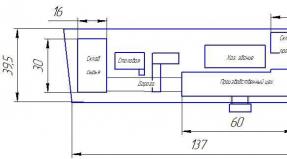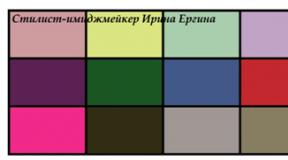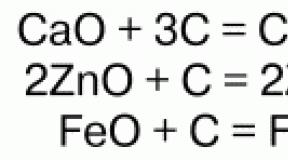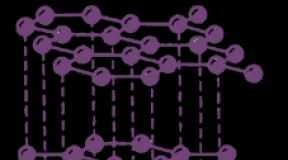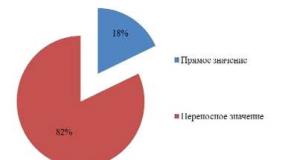What is the name of the comma in a decimal. Decimals. What fractions exist
To write a rational number m / n as a decimal fraction, you need to divide the numerator by the denominator. In this case, the quotient is written as a finite or infinite decimal fraction.
Write the given number as a decimal.
Solution. Divide the numerator of each fraction by its denominator: a) divide 6 by 25; b) divide 2 by 3; v) divide 1 by 2, and then add the resulting fraction to unity - the integer part of this mixed number.

Irreducible ordinary fractions whose denominators contain no prime divisors other than 2 and 5 , are written as a final decimal fraction.
V example 1 when a) denominator 25=5 5; when v) the denominator is 2, so we got the final decimals 0.24 and 1.5. When b) the denominator is 3, so the result cannot be written as a final decimal.
Is it possible, without dividing into a column, to convert such an ordinary fraction into a decimal fraction, the denominator of which does not contain other divisors, except 2 and 5? Let's figure it out! What fraction is called decimal and is written without a fractional line? Answer: a fraction with a denominator of 10; one hundred; 1000 etc. And each of these numbers is a product equal number of twos and fives. Actually: 10=2 5 ; 100=2 5 2 5 ; 1000=2 5 2 5 2 5 etc.
Therefore, the denominator of an irreducible ordinary fraction will need to be represented as a product of “twos” and “fives”, and then multiplied by 2 and (or) by 5 so that “twos” and “fives” become equal. Then the denominator of the fraction will be equal to 10 or 100 or 1000, etc. So that the value of the fraction does not change, we multiply the numerator of the fraction by the same number by which the denominator was multiplied.
Express the following fractions as a decimal:
![]()
Solution. Each of these fractions is irreducible. Let us decompose the denominator of each fraction into prime factors.
20=2 2 5. Conclusion: one "five" is missing.
8=2 2 2. Conclusion: there are not enough three "fives".
25=5 5. Conclusion: two "twos" are missing.

Comment. In practice, they often do not use the factorization of the denominator, but simply ask the question: by how much should the denominator be multiplied so that the result is a unit with zeros (10 or 100 or 1000, etc.). And then the numerator is multiplied by the same number.
So, in case a)(example 2) from the number 20 you can get 100 by multiplying by 5, therefore, you need to multiply the numerator and denominator by 5.
When b)(example 2) from the number 8, the number 100 will not work, but the number 1000 will be obtained by multiplying by 125. Both the numerator (3) and the denominator (8) of the fraction are multiplied by 125.
When v)(example 2) out of 25 you get 100 when multiplied by 4. This means that the numerator 8 must also be multiplied by 4.
An infinite decimal fraction in which one or more digits invariably repeat in the same sequence is called periodical decimal fraction. The set of repeating digits is called the period of this fraction. For brevity, the period of a fraction is written once, enclosing it in parentheses.
When b)(example 1 ) the repeated digit is one and equals 6. Therefore, our result 0.66... will be written like this: 0,(6) . They read: zero integers, six in the period.
If there is one or more non-recurring digits between the comma and the first period, then such a periodic fraction is called a mixed periodic fraction.
An irreducible common fraction whose denominator together with others multiplier contains multiplier 2 or 5 , becomes mixed periodic fraction.
Write the number as a decimal.
We will devote this material to such an important topic as decimal fractions. First, let's define the basic definitions, give examples and dwell on the rules of decimal notation, as well as what the digits of decimal fractions are. Next, we highlight the main types: finite and infinite, periodic and non-periodic fractions. In the final part, we will show how the points corresponding to fractional numbers are located on the coordinate axis.
What is decimal notation for fractional numbers
The so-called decimal notation for fractional numbers can be used for both natural and fractional numbers. It looks like a set of two or more numbers with a comma between them.
The decimal point is used to separate the integer part from the fractional part. As a rule, the last digit of a decimal is never a zero, unless the decimal point is immediately after the first zero.
What are some examples of fractional numbers in decimal notation? It can be 34 , 21 , 0 , 35035044 , 0 , 0001 , 11 231 552 , 9 etc.
In some textbooks, you can find the use of a dot instead of a comma (5. 67, 6789. 1011, etc.). This option is considered equivalent, but it is more typical for English-language sources.
Definition of decimals
Based on the above concept of decimal notation, we can formulate the following definition of decimal fractions:
Definition 1
Decimals are fractional numbers in decimal notation.
Why do we need to write fractions in this form? It gives us some advantages over ordinary ones, for example, a more compact notation, especially in cases where the denominator is 1000, 100, 10, etc. or a mixed number. For example, instead of 6 10 we can specify 0 , 6 , instead of 25 10000 - 0 , 0023 , instead of 512 3 100 - 512 , 03 .
How to properly present decimal ordinary fractions with tens, hundreds, thousands in the denominator, will be described in a separate material.
How to read decimals correctly
There are some rules for reading records of decimals. So, those decimal fractions that correspond to their correct ordinary equivalents are read almost the same, but with the addition of the words "zero tenths" at the beginning. So, the entry 0 , 14 , which corresponds to 14 100 , is read as "zero point fourteen hundredths."
If a decimal fraction can be associated with a mixed number, then it is read in the same way as this number. So, if we have a fraction 56, 002, which corresponds to 56 2 1000, we read such an entry as "fifty-six point two thousandths."
The value of a digit in a decimal notation depends on where it is located (just like in the case of natural numbers). So, in decimal fraction 0, 7, seven is tenths, in 0, 0007 it is ten thousandths, and in fraction 70,000, 345 it means seven tens of thousands of whole units. Thus, in decimal fractions, there is also the concept of a number digit.
The names of the digits located before the comma are similar to those that exist in natural numbers. The names of those that are located after are clearly presented in the table:
Let's take an example.
Example 1
We have decimal 43, 098. She has a four in the tens place, a three in the units place, zero in the tenth place, 9 in the hundredth place, and 8 in the thousandth place.
It is customary to distinguish the digits of decimal fractions by seniority. If we move through the numbers from left to right, then we will go from high to low digits. It turns out that hundreds are older than tens, and millionths are younger than hundredths. If we take that final decimal fraction, which we cited as an example above, then in it the senior, or highest, will be the digit of hundreds, and the lowest, or lowest, will be the digit of 10 thousandths.
Any decimal fraction can be decomposed into separate digits, that is, represented as a sum. This operation is performed in the same way as for natural numbers.
Example 2
Let's try to expand the fraction 56, 0455 into digits.
We will be able to:
56 , 0455 = 50 + 6 + 0 , 4 + 0 , 005 + 0 , 0005
If we remember the properties of addition, we can represent this fraction in other forms, for example, as the sum 56 + 0, 0455, or 56, 0055 + 0, 4, etc.
What are trailing decimals
All the fractions we talked about above are trailing decimals. This means that the number of digits after the decimal point is finite. Let's get the definition:
Definition 1
Trailing decimals are a type of decimal that has a finite number of digits after the comma.
Examples of such fractions can be 0, 367, 3, 7, 55, 102567958, 231032, 49, etc.
Any of these fractions can be converted either into a mixed number (if the value of their fractional part is different from zero), or into an ordinary fraction (if the integer part is zero). We have devoted a separate material to how this is done. Here we will just indicate a couple of examples: for example, we can bring the final decimal fraction 5, 63 to the form 5 63 100, and 0, 2 corresponds to 2 10 (or any other fraction equal to it, for example, 4 20 or 1 5 .)
But the reverse process, i.e. writing an ordinary fraction in decimal form may not always be performed. So, 5 13 cannot be replaced by an equal fraction with a denominator of 100, 10, etc., which means that the final decimal fraction will not work out of it.
The main types of infinite decimal fractions: periodic and non-periodic fractions
We pointed out above that finite fractions are called so because they have a finite number of digits after the decimal point. However, it may well be infinite, in which case the fractions themselves will also be called infinite.
Definition 2
Infinite decimals are those that have an infinite number of digits after the decimal point.
Obviously, such numbers simply cannot be written completely, so we indicate only a part of them and then put ellipsis. This sign indicates an infinite continuation of the sequence of decimal places. Examples of infinite decimals would be 0 , 143346732 ... , 3 , 1415989032 ... , 153 , 0245005 ... , 2 , 66666666666 ... , 69 , 748768152 ... . etc.
In the "tail" of such a fraction, there can be not only seemingly random sequences of numbers, but a constant repetition of the same character or group of characters. Fractions with alternation after the decimal point are called periodic.
Definition 3
Periodic decimal fractions are such infinite decimal fractions in which one digit or a group of several digits is repeated after the decimal point. The repeating part is called the period of the fraction.
For example, for the fraction 3, 444444 ... . the period will be the number 4, and for 76, 134134134134 ... - the group 134.
What is the minimum number of characters allowed in a periodic fraction? For periodic fractions, it will be sufficient to write the entire period once in parentheses. So, the fraction is 3, 444444 ... . it will be correct to write as 3, (4) , and 76, 134134134134 ... - as 76, (134) .
In general, entries with multiple periods in brackets will have exactly the same meaning: for example, the periodic fraction 0.677777 is the same as 0.6 (7) and 0.6 (77), etc. Entries like 0 , 67777 (7) , 0 , 67 (7777) and others are also allowed.
In order to avoid errors, we introduce the uniformity of notation. Let's agree to write only one period (the shortest possible sequence of digits), which is closest to the decimal point, and enclose it in parentheses.
That is, for the above fraction, we will consider the entry 0, 6 (7) as the main one, and, for example, in the case of the fraction 8, 9134343434, we will write 8, 91 (34) .
If the denominator of an ordinary fraction contains prime factors that are not equal to 5 and 2, then when converted to decimal notation, infinite fractions will be obtained from them.
In principle, we can write any finite fraction as a periodic one. To do this, we just need to add an infinite number of zeros to the right. How does it look on the record? Let's say we have a final fraction 45, 32. In periodic form, it will look like 45 , 32 (0) . This action is possible because adding zeros to the right of any decimal fraction gives us a fraction equal to it as a result.
Separately, one should dwell on periodic fractions with a period of 9, for example, 4, 89 (9), 31, 6 (9) . They are an alternative notation for similar fractions with a period of 0, so they are often replaced when writing with fractions with a zero period. At the same time, one is added to the value of the next digit, and (0) is indicated in parentheses. The equality of the resulting numbers is easy to check by presenting them as ordinary fractions.
For example, the fraction 8, 31 (9) can be replaced by the corresponding fraction 8, 32 (0) . Or 4 , (9) = 5 , (0) = 5 .
Infinite decimal periodic fractions are rational numbers. In other words, any periodic fraction can be represented as an ordinary fraction, and vice versa.
There are also fractions in which there is no infinitely repeating sequence after the decimal point. In this case, they are called non-periodic fractions.
Definition 4
Non-periodic decimal fractions include those infinite decimal fractions that do not contain a period after the decimal point, i.e. repeating group of numbers.
Sometimes non-periodic fractions look very similar to periodic ones. For example, 9 , 03003000300003 ... at first glance seems to have a period, but a detailed analysis of the decimal places confirms that this is still a non-periodic fraction. You have to be very careful with numbers like this.
Non-periodic fractions are irrational numbers. They are not converted to ordinary fractions.
Basic operations with decimals
The following operations can be performed with decimal fractions: comparison, subtraction, addition, division and multiplication. Let's analyze each of them separately.
Comparing decimals can be reduced to comparing ordinary fractions that correspond to the original decimals. But infinite non-periodic fractions cannot be reduced to this form, and converting decimal fractions to ordinary ones is often a laborious task. How to quickly perform a comparison action if we need to do it in the course of solving the problem? It is convenient to compare decimal fractions by digits in the same way as we compare natural numbers. We will devote a separate article to this method.
To add one decimal fraction to another, it is convenient to use the column addition method, as for natural numbers. To add periodic decimal fractions, you must first replace them with ordinary ones and count according to the standard scheme. If, according to the conditions of the problem, we need to add infinite non-periodic fractions, then we must first round them up to a certain digit, and then add them. The smaller the digit to which we round, the higher the accuracy of the calculation will be. For subtraction, multiplication and division of infinite fractions, preliminary rounding is also necessary.
Finding the difference of decimal fractions is the opposite of addition. In fact, with the help of subtraction, we can find a number whose sum with the subtracted fraction will give us the reduced one. We will talk about this in more detail in a separate article.
Multiplication of decimal fractions is done in the same way as for natural numbers. The method of calculation by a column is also suitable for this. We again reduce this action with periodic fractions to the multiplication of ordinary fractions according to the rules already studied. Infinite fractions, as we remember, must be rounded before counting.
The process of dividing decimals is the reverse of the multiplication process. When solving problems, we also use column counts.
You can set an exact correspondence between the end decimal and a point on the coordinate axis. Let's figure out how to mark a point on the axis that will exactly correspond to the required decimal fraction.
We have already studied how to construct points corresponding to ordinary fractions, and decimal fractions can be reduced to this form. For example, an ordinary fraction 14 10 is the same as 1 , 4 , so the point corresponding to it will be removed from the origin in the positive direction by exactly the same distance:

You can do without replacing the decimal fraction with an ordinary one, and take the digit expansion method as a basis. So, if we need to mark a point whose coordinate will be equal to 15 , 4008 , then we will first represent this number as a sum 15 + 0 , 4 + , 0008 . To begin with, we set aside 15 whole unit segments in the positive direction from the origin, then 4 tenths of one segment, and then 8 ten-thousandths of one segment. As a result, we will get a coordinate point, which corresponds to the fraction 15, 4008.
For an infinite decimal fraction, it is better to use this particular method, since it allows you to approach the desired point as close as you like. In some cases, it is possible to build an exact correspondence of an infinite fraction on the coordinate axis: for example, 2 = 1, 41421. . . , and this fraction can be associated with a point on the coordinate ray, remote from 0 by the length of the diagonal of the square, the side of which will be equal to one unit segment.
If we find not a point on the axis, but a decimal fraction corresponding to it, then this action is called the decimal measurement of the segment. Let's see how to do it right.
Suppose we need to get from zero to a given point on the coordinate axis (or get as close as possible in the case of an infinite fraction). To do this, we gradually set aside unit segments from the origin of coordinates until we get to the desired point. After whole segments, if necessary, we measure tenths, hundredths and smaller parts so that the correspondence is as accurate as possible. As a result, we got a decimal fraction that corresponds to a given point on the coordinate axis.
Above we gave a picture with a point M. Look at it again: to get to this point, you need to measure one unit segment from zero and four tenths of it, since this point corresponds to the decimal fraction 1, 4.
If we cannot hit a point in the process of decimal measurement, then it means that an infinite decimal fraction corresponds to it.
If you notice a mistake in the text, please highlight it and press Ctrl+Enter
For instance.$\frac(3)(10), 4 \frac(7)(100), \frac(11)(10000)$
Such fractions are usually written without a denominator, and the value of each digit depends on the place where it stands. For such fractions, the integer part is separated by a comma, and after the comma there should be as many digits as there are zeros in the denominator of an ordinary fraction. The fractional digits are called decimal places.
For instance.$\frac(21)(100)=0.21 ; 3 \frac(21)(100)=$3.21
The first decimal place after the decimal point corresponds to tenths, the second to hundredths, the third to thousandths, and so on.
If the number of zeros in the denominator of a decimal fraction is greater than the number of digits in the numerator of the same fraction, then after the decimal point, the required number of zeros is added before the digits of the numerator.

Since there are four zeros in the denominator, and two digits in the numerator, we add $4-2=2$ zeros in the decimal notation before the numerator.
The main property of a decimal fraction
Property
If you add several zeros to the decimal fraction on the right, then the value of the decimal fraction will not change.
For instance.$12.034=12.0340=12.03400=12.034000=\ldots$
Comment
Thus, the zeros at the end of the decimal are not taken into account, so when performing various actions, these zeros can be crossed out / discarded.
Decimal Comparison
To compare two decimals (to find out which of the two decimals is greater), you need to compare their whole parts, then tenths, hundredths, and so on. If the integer part of one of the fractions is greater than the integer part of the other fraction, then the first fraction is considered larger. In the case of equality of integer parts, the fraction with more tenths is greater, etc.
Example
Exercise. Compare fractions $2,432$ ; $2.41 and $1.234
Solution. The fraction $1,234$ is the smallest because its integer part is 1 and $1
Now let's compare the fractions $2,432$ and $1,234$ in size. Their integer parts are equal to each other and equal to 2. Compare tenths: $4=4$ . Compare hundredths: $3>1$ . So $2.432>2.41$ .
Decimal fractions are the same ordinary fractions, but in the so-called decimal notation. Decimal notation is used for fractions with denominators 10, 100, 1000, etc. In this case, instead of fractions 1/10; 1/100; 1/1000; ... write 0.1; 0.01; 0.001;... .
For example, 0.7 ( zero point seven) is a fraction 7/10; 5.43 ( five point forty-three hundredths) is a mixed fraction 5 43/100 (or, equivalently, an improper fraction 543/100).
It may happen that there is one or more zeros immediately after the decimal point: 1.03 is the fraction 1 3/100; 17.0087 is the fraction 1787/10000. General rule is this: there must be as many zeros in the denominator of an ordinary fraction as there are digits after the decimal point in the decimal fraction.
A decimal can end in one or more zeros. It turns out that these zeros are “extra” - they can simply be removed: 1.30 = 1.3; 5.4600 = 5.46; 3,000 = 3. Can you figure out why this is so?
Decimals naturally arise when dividing by "round" numbers - 10, 100, 1000, ... Be sure to understand the following examples:
27:10 = 27/10 = 2 7/10 = 2,7;
579:100 = 579/100 = 5 79/100 = 5,79;
33791:1000 = 33791/1000 = 33 791/1000 = 33,791;
34,9:10 = 349/10:10 = 349/100 = 3,49;
6,35:100 = 635/100:100 = 635/10000 = 0,0635.
Do you notice a pattern here? Try to formulate it. What happens if you multiply a decimal by 10, 100, 1000?
To convert an ordinary fraction to a decimal, you need to bring it to some kind of "round" denominator:
2/5 = 4/10 = 0.4; 11/20 = 55/100 = 0.55; 9/2 = 45/10 = 4.5 etc.
Adding decimal fractions is much more convenient than ordinary fractions. Addition is performed in the same way as with ordinary numbers - according to the corresponding digits. When adding in a column, the terms must be written so that their commas are on the same vertical. The sum comma will also appear on the same vertical. The subtraction of decimal fractions is performed in exactly the same way.
If, when adding or subtracting in one of the fractions, the number of digits after the decimal point is less than in the other, then the required number of zeros should be added at the end of this fraction. You can not add these zeros, but simply imagine them in your mind.
When multiplying decimal fractions, they should again be multiplied as ordinary numbers (in this case, it is no longer necessary to write a comma under a comma). In the result obtained, you need to separate with a comma the number of characters equal to the total number of decimal places in both factors.
When dividing decimal fractions, you can simultaneously move the comma to the right by the same number of digits in the dividend and divisor: the quotient will not change from this:
2,8:1,4 = 2,8/1,4 = 28/14 = 2;
4,2:0,7 = 4,2/0,7 = 42/7 = 6;
6:1,2 = 6,0/1,2 = 60/12 = 5.
Explain why this is so?
- Draw a 10x10 square. Paint over some part of it equal to: a) 0.02; b) 0.7; c) 0.57; d) 0.91; e) 0.135 of the area of the whole square.
- What is 2.43 squares? Draw in the picture.
- Divide 37 by 10; 795; 4; 2.3; 65.27; 0.48 and write the result as a decimal fraction. Divide these numbers by 100 and 1000.
- Multiply by 10 the numbers 4.6; 6.52; 23.095; 0.01999. Multiply these numbers by 100 and 1000.
- Express the decimal as a fraction and reduce it:
a) 0.5; 0.2; 0.4; 0.6; 0.8;
b) 0.25; 0.75; 0.05; 0.35; 0.025;
c) 0.125; 0.375; 0.625; 0.875;
d) 0.44; 0.26; 0.92; 0.78; 0.666; 0.848. - Imagine as a mixed fraction: 1.5; 3.2; 6.6; 2.25; 10.75; 4.125; 23.005; 7.0125.
- Write a common fraction as a decimal:
a) 1/2; 3/2; 7/2; 15/2; 1/5; 3/5; 4/5; 18/5;
b) 1/4; 3/4; 5/4; 19/4; 1/20; 7/20; 49/20; 1/25; 13/25; 77/25; 1/50; 17/50; 137/50;
c) 1/8; 3/8; 5/8; 7/8; 11/8; 125/8; 1/16; 5/16; 9/16; 23/16;
d) 1/500; 3/250; 71/200; 9/125; 27/2500; 1999/2000. - Find the sum: a) 7.3 + 12.8; b) 65.14+49.76; c) 3.762+12.85; d) 85.4+129.756; e) 1.44+2.56.
- Think of a unit as the sum of two decimals. Find twenty more ways to do this.
- Find the difference: a) 13.4–8.7; b) 74.52–27.04; c) 49.736–43.45; d) 127.24–93.883; e) 67–52.07; f) 35.24–34.9975.
- Find the product: a) 7.6 3.8; b) 4.8 12.5; c) 2.39 7.4; d) 3.74 9.65.
A decimal fraction differs from an ordinary fraction in that its denominator is a bit unit.
For instance:
Decimal fractions have been separated from ordinary fractions into a separate form, which has led to its own rules for comparing, adding, subtracting, multiplying and dividing these fractions. In principle, you can work with decimal fractions according to the rules of ordinary fractions. Own rules for converting decimal fractions simplify calculations, and rules for converting ordinary fractions to decimals, and vice versa, serve as a link between these types of fractions.
Writing and reading decimal fractions allows you to write, compare and operate on them according to rules very similar to the rules for operations with natural numbers.
For the first time, the system of decimal fractions and operations on them was described in the 15th century. Samarkand mathematician and astronomer Jamshid ibn-Masudal-Kashi in the book "The Key to the Art of Accounting".
The integer part of the decimal fraction is separated from the fractional part by a comma, in some countries (USA) they put a period. If there is no integer part in the decimal fraction, then put the number 0 before the decimal point.
Any number of zeros can be added to the fractional part of the decimal fraction on the right, this does not change the value of the fraction. The fractional part of the decimal fraction is read by the last significant digit.
For instance:
0.3 - three tenths
0.75 - seventy-five hundredths
0.000005 - five millionths.
Reading the integer part of a decimal is the same as reading natural numbers.
For instance:
27.5 - twenty-seven ...;
1.57 - one...
After the integer part of the decimal fraction, the word "whole" is pronounced.
For instance:
10.7 - ten point seven
0.67 - zero point sixty-seven hundredths.
Decimals are fractional digits. The fractional part is read not by digits (unlike natural numbers), but as a whole, therefore the fractional part of a decimal fraction is determined by the last significant digit to the right. The bit system of the fractional part of a decimal fraction is somewhat different than that of natural numbers.
- 1st digit after busy - tenths digit
- 2nd place after the decimal point - hundredth place
- 3rd place after the decimal point - thousandth place
- 4th place after the decimal point - ten-thousandth place
- 5th place after the decimal point - hundred-thousandth place
- 6th place after the decimal point - millionth place
- 7th place after the decimal point - ten-millionth place
- The 8th place after the decimal point is the hundred-millionth place
In calculations, the first three digits are most often used. The large bit depth of the fractional part of decimal fractions is used only in specific branches of knowledge, where infinitesimal values are calculated.
Decimal to mixed fraction conversion consists of the following: write the number before the decimal point as the integer part of the mixed fraction; the number after the decimal point is the numerator of its fractional part, and in the denominator of the fractional part, write one with as many zeros as there are digits after the decimal point.


